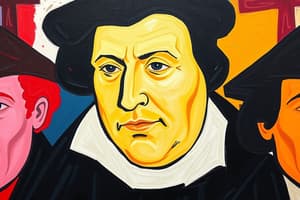Podcast
Questions and Answers
Flashcards
Chorales
Chorales
Simple, catchy hymns sung by everyone in a Lutheran church service.
Calvinist music
Calvinist music
Simple psalm singing in unison, without instruments, emphasizing biblical text and avoiding distractions.
Polyphonic settings
Polyphonic settings
Music with multiple independent musical lines sung simultaneously, creating harmonic complexity.
Counter-Reformation
Counter-Reformation
Signup and view all the flashcards
Council of Trent
Council of Trent
Signup and view all the flashcards
Palestrina
Palestrina
Signup and view all the flashcards
Gregorian chant
Gregorian chant
Signup and view all the flashcards
English Church Music
English Church Music
Signup and view all the flashcards
Instrumental Music Takes Center Stage
Instrumental Music Takes Center Stage
Signup and view all the flashcards
Ricercare and Canzona
Ricercare and Canzona
Signup and view all the flashcards
Giovanni Gabrieli
Giovanni Gabrieli
Signup and view all the flashcards
Baroque Era
Baroque Era
Signup and view all the flashcards
Basso Continuo
Basso Continuo
Signup and view all the flashcards
Shift from Modal Music to Tonal System
Shift from Modal Music to Tonal System
Signup and view all the flashcards
Opera's Birth
Opera's Birth
Signup and view all the flashcards
Monteverdi's L'Orfeo
Monteverdi's L'Orfeo
Signup and view all the flashcards
Study Notes
Studying That Suits You
Use AI to generate personalized quizzes and flashcards to suit your learning preferences.




